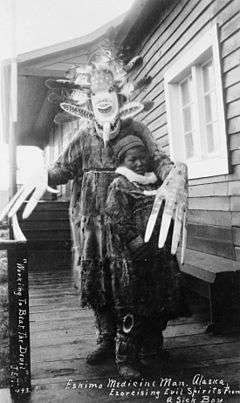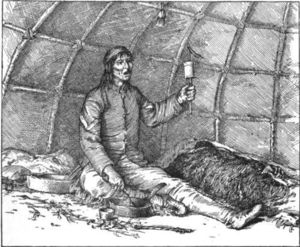Medicine man
A medicine man or medicine woman is a traditional healer and spiritual leader who serves a community of Indigenous people. Individual cultures have their own names, in their respective Indigenous languages, for the spiritual healers and ceremonial leaders in their particular cultures.
The medicine man and woman in North America
Cultural context

In the ceremonial context of Indigenous North American communities, "medicine" usually refers to spiritual healing. Medicine men/women should not be confused with those who employ Native American ethnobotany, a practice that is very common in a large number of Native American and First Nations households.[2][3][4]
The terms "medicine people" or "ceremonial people" are sometimes used in Native American and First Nations communities, for example, when Arwen Nuttall (Cherokee) of the National Museum of the American Indian writes, "The knowledge possessed by medicine people is privileged, and it often remains in particular families."[5]
Native Americans tend to be quite reluctant to discuss issues about medicine or medicine people with non-Indians. In some cultures, the people will not even discuss these matters with Indians from other tribes. In most tribes, medicine elders are prohibited from advertising or introducing themselves as such. As Nuttall writes, "An inquiry to a Native person about religious beliefs or ceremonies is often viewed with suspicion.[5] One example of this is the Apache medicine cord or Izze-kloth whose purpose and use by Apache medicine elders was a mystery to nineteenth century ethnologists because "the Apache look upon these cords as so sacred that strangers are not allowed to see them, much less handle them or talk about them."[6]
The 1954 version of Webster's New World Dictionary of the American Language reflects the poorly-grounded perceptions of the people whose use of the term effectively defined it for the people of that time: "a man supposed to have supernatural powers of curing disease and controlling spirits." In effect, such definitions were not explanations of what these "medicine people" are to their own communities but instead reported on the consensus of socially and psychologically remote observers when they tried to categorize the individuals. The term "medicine man/woman," like the term "shaman," has been criticized by Native Americans, as well as other specialists in the fields of religion and anthropology.
While non-Native anthropologists sometimes use the term "shaman," for Indigenous healers worldwide, including the Americas, "shaman" is the specific name for a spiritual mediator from the Tungusic peoples of Siberia[7] and is not used in Native American or First Nations communities.
The term "medicine man/woman" has also frequently been used by Europeans to refer to African traditional healers, along with the offensive term, "witch doctors".
Medicine Men and Women in the Cherokee Tribe
History
Cherokee Medicine People are considered the chosen ones within their tribe. The knowledge has been passed down for thousands of years. The Cherokee tribe is one of the first tribes to form a written language to record their knowledge of formulas and secrets onto a ledger.[8] Some of the information in these ledgers are in written code or backwards to prevent other people from trying to use the ledger for their own purposes. A Cherokee Medicine person is not considered a "doctor", because they are known to have supernatural powers that could heal.[9] The Medicine people kept their tools that they used to heal other tribal members in a medicine bundle. When a Medicine Person treated their patients it was completely up to the person who was being treated if they did not want the medicine or not just in case they had any additional beliefs. Another way Medicine people would treat their patients were by using sweat lodges and steam baths to get rid of any evils or to detox their bodies. [10] In 1978, the American Indian Religious Freedom Act was passed, which allowed Medicine People to begin practicing again. Since Practicing medicine was banned decades ago it completely faded, which is the reason why only a handful still practice this today.[9]
Training
Training a Cherokee Medicine Person took years due to the vast amount of knowledge needed to practice.[8] They would learn secrets and formulas that they would record in ledgers. When a medicine person would learn new secrets and formulas it is important that they are not interrupted while recording their knowledge.[10] It is also important that if one is not trained to use the knowledge they should not try to practice it without proper training. Another part of training was going into the mountains where they would dance, sing, and tell stories for seven days while learning new secrets from the little people. On the seventh day the Medicine People would dance in a circle at the darkest hour while the drums get louder while they danced to sacred songs. [9]After seven days they would return and go back once a year to pass down secrets to the little people. A Cherokee Medicine person is always learning new formulas and secrets to help aid the wounded within their tribe.[9]
Modern Day
Modern-day Cherokee Medicine people are not considered "shamans", because they consult other medicine people for medical advice. But there are not that many traditional Cherokee Medicine people in today's society. They are still very important to the Cherokee tribe. In order to seek help from a Cherokee medicine person you need to know someone in the tribe in order to proceed. Calling or trying to contact a Cherokee Medicine Person is forbidden[8] The reason why many tribal members still seek medical attention from Medicine People is because they do not believe that modern medicine is going to help them. They believe that herbal remedies will take away the sickness if used in correct amounts. If the tribe were to share any of this knowledge to outsiders, then it would make these herbal practices and rituals weak.[9]
See also
Notes
- ↑ Fienup-Riordan, Ann. (1994). Boundaries & Passages: Rule and Ritual in Yup'ik Eskimo Oral Tradition. Norman, OK: University of Oklahoma Press, p. 206. Nushagak, located on Nushagak Bay of the Bering Sea in southwest Alaska, is part of the territory of the Yup'ik, speakers of the Central Alaskan Yup'ik language.
- ↑ Alcoze, Dr Thomas M. "Ethnobotany from a Native American Perspective: Restoring Our Relationship with the Earth" in Botanic Gardens Conservation International Volume 1 Number 19 - December 1999
- ↑ Moerman, Daniel E. "Symbols and selectivity: A statistical analysis of native american medical ethnobotany" in Journal of Ethnopharmacology Volume 1, Issue 2, April 1979, Pages 111-119
- ↑ Northeastern Area State and Private Forestry, "Traditional Ecological Knowledge: Sustaining Our Lives and the Natural World" at United States Department of Agriculture, Forest Service. Newtown Square, PA. December 2011
- 1 2 National Museum of the American Indian. Do All Indians Live in Tipis? Washington DC: Smithsonian Institution, 2007. ISBN 978-0-06-115301-3.
- ↑ Smithsonian Institution, Bureau of American Ethnology, Annual report of the Bureau of American Ethnology to the secretary of the Smithsonian Institution, Issue 9, Government Printing Office, United States Government, 1892,
There is probably no more mysterious or interesting portion of the religious or 'medicinal' equipment of the Apache Indian, whether he be medicine-man or simply a member of the laity, than the 'izze-kloth' or medicine cord... the Apache look upon these cords as so sacred that strangers are not allowed to see them, much less handle them or talk about them....
- ↑ Smith, C. R. "Shamanism." Cabrillo College. (Retrieved 28 June 2011)
- 1 2 3 "Cherokee Medicine Men and Women". www.cherokee.org. Retrieved 2016-11-20.
- 1 2 3 4 5 "Native American Medicine - History and Information". www.legendsofamerica.com. Retrieved 2016-11-20.
- 1 2 "Native American Indian Legends - Cherokee Medicine Man - Cherokee". www.firstpeople.us. Retrieved 2016-11-20.
External links
- New Age Frauds & Plastic Shaman, an organization devoted to discussing fraudulent medicine people
